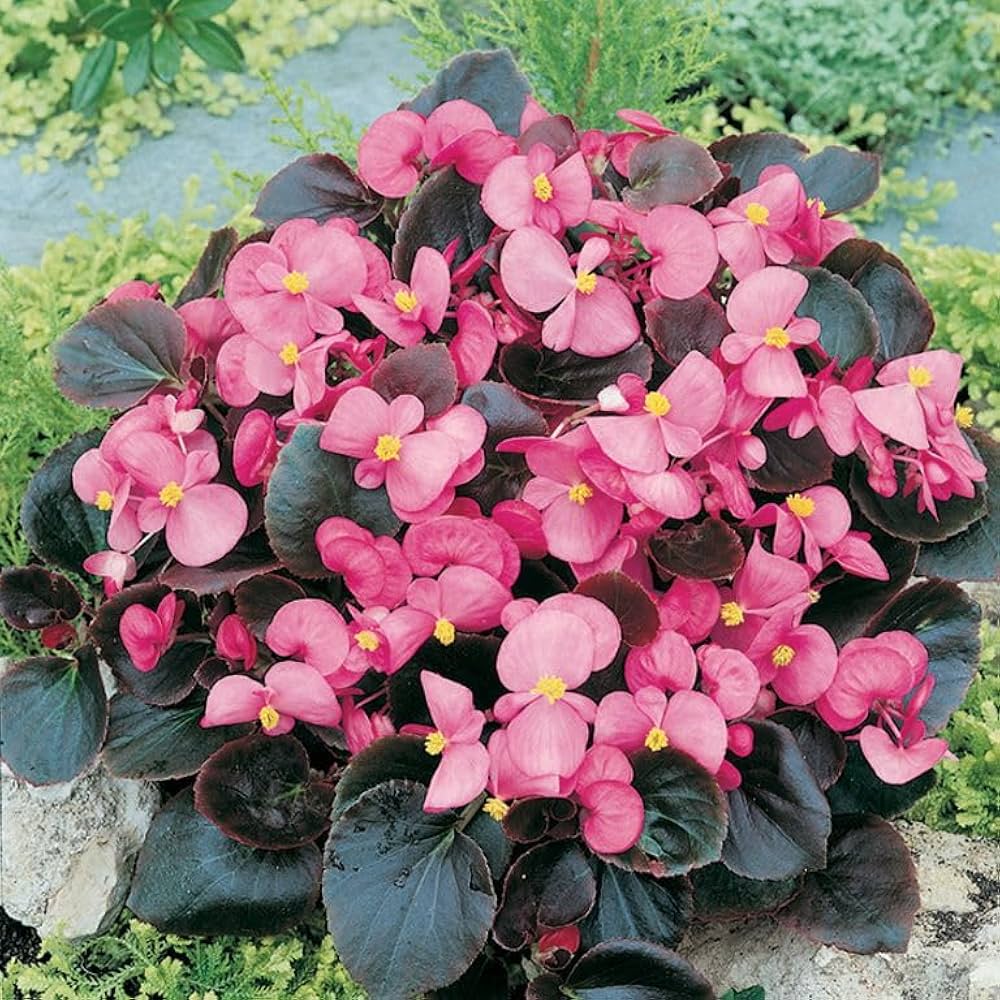Discover Begonia Brilliance Cultivating Beauty
"Explore Sai Nursery's begonia collection, where beauty meets expertise. From vibrant foliage to exquisite blooms, discover diverse varieties perfect for any space.
Begonias, known for their vibrant foliage and exquisite blooms, are a testament to nature's artistry. These plants come in a stunning array of varieties, each with its unique charm. Whether you're an experienced gardener or a novice, begonias are the perfect choice to add color and elegance to your garden or indoor space.

Begonia Care Guide
Watering
Begonias have average water needs. Water them when the top 3 cm of soil has dried out.
Fertilization
Fertilize begonias once in spring.
Pruning
Deadhead withered flowers after they have bloomed.
Planting Time
Plant begonias in spring or autumn.
Propagation
Propagate begonias through sowing seeds, taking cuttings, or division.
Potting Suggestions
Plant begonias in shallow, tile pots with excellent drainage.
Conditions Requirement
Difficulty Rating
Wax begonia is super easy to take care of, with resistance to almost all pests and diseases. It is a perfect option for gardeners with brown thumbs.
Sunlight
Partial sun
Hardiness
-9°C
Hardiness Zones
10-11
Soil
Clay, loam, sand; well-drained; slightly acidic to neutral
Sunlight Requirements for Wax Begonia
Wax begonia prefers bright, filtered sunlight. Only a few species can tolerate strong sunlight. The plant is sensitive to light, and its leaves are prone to burning under intense sunlight.
Indoor Planting:
Place the begonia next to windows to ensure it receives sufficient scattered light during the day. The optimal exposure time is 4-6 hours.
Outdoor Planting:
Plant wax begonia in the shade under trees with less dense foliage to allow adequate scattered light to reach the plant.
Soil Requirements for Wax Begonia
Wax begonia thrives in a well-drained mixture of sandy soil, clay, and loam, with a suitable pH range of 5.5-6.2. However, it tends to grow better in soilless environments than in conventional soil.
Soilless Media:
- Ready-made soilless culture media are available for purchase.
- Alternatively, mix 2/3 peat moss or peat with 1/3 other soilless culture media such as vermiculite, bark, and perlite.
This combination provides a slightly acidic and well-drained medium ideal for wax begonia.
To ensure optimal nutrition, wax begonia prefers properly diluted fertilizers or fertilizers mixed with a little compost and peat moss.
Fertilization Schedule:
- After Flowering: Begin regular fertilizer application, but not too frequently.
- Frequency: Apply liquid fertilizer about once a month.
- Fertilizer Types: Choose different kinds of fertilizer according to the plant's needs.
Caution:
- Wax begonia is sensitive to excessive fertilizer. High concentrations can damage the leaves.
- Avoid frequent fertilization in late fall and winter, as the plant's growth slows or it may enter dormancy.
Summary of Wax Begonia Care Guide
Watering:
- Average water needs; water when the top 3 cm of soil has dried out.
Fertilization:
- Fertilize once in spring and apply liquid fertilizer monthly after flowering.
Pruning:
- Deadhead withered flowers after blooming.
Planting Time:
- Spring or autumn.
Propagation:
- Sowing, cuttings, or division.
Potting Suggestions:
- Shallow tile pots with excellent drainage.
Sunlight:
- Bright filtered sunlight; sensitive to strong sunlight; 4-6 hours of exposure recommended.
Hardiness:
- Can tolerate temperatures as low as -9°C; Hardiness Zones 10-11.
Soil:
- Well-drained mix of sandy soil, clay, and loam with pH 5.5-6.2.
- Prefers soilless media with 2/3 peat moss and 1/3 vermiculite, bark, or perlite.
Fertilizer:
- Use diluted fertilizers or those mixed with compost and peat moss; avoid high concentrations and frequent application in late fall and winter.
Seasonal Precautions for Wax Begonia
Summer Care:
- Shade: During hot summers, move potted wax begonias to cool, shaded areas.
- Pruning: Regularly prune dense branches and leaves to improve airflow.
- Watering: Water the plants in the cool morning or evening to prevent heat stress.
Winter Care:
- Indoor Transfer: Move potted wax begonias indoors or into greenhouses for protection.
- Warming Measures: For plants in open fields, provide appropriate warming measures:
- Cover with 5 cm of peat moss, tree leaves, sawdust, or straw.
- Use fabrics or cardboard boxes to cover the plants.
- Avoid Compression: Ensure that coverings do not oppress the plants
Common Problems and Winter Care for Tuberous Begonia Bulbs
Winter Care for Tuberous Begonia Bulbs:
In Frost-Prone Areas:
- Digging Up Bulbs: After the first frost or when a large number of leaves fall, dig up the bulbs.
- Preparation: Cut off the withered leaves and remove any rotten parts.
- Drying Tubers: Leave the bulbs in a warm, dry environment for several days to dry the tubers.
- Storage: Place the dried tubers in a paper bag and store them in a cool, dry place indoors for the winter.
In Frost-Free or Frostless Areas:
- Dormancy: Tuberous begonias will begin dormancy on their own in the fall, depending on the length of the day.
- Outdoor Care: If planted in open fields, follow the same measures as in cold areas. Dig up the bulbs, keep them dry, and protect them from rain during winter.
- Potted Plants: Move potted tuberous begonias to a cool, dry area and stop watering them during dormancy.
Conclusion
At Sai Nursery, we pride ourselves on providing a wide variety of begonias and expert care advice to ensure your gardening success. Whether you're looking to enhance your indoor space with vibrant foliage or add elegance to your garden with exquisite blooms, our diverse selection of begonias offers something for every enthusiast, from seasoned gardeners to beginners. With our comprehensive care guides and commitment to quality, Sai Nursery is your trusted partner in cultivating beautiful and thriving begonias year-round.
Also Read: Things You Need to Know About Bougainvillea Plant Care
